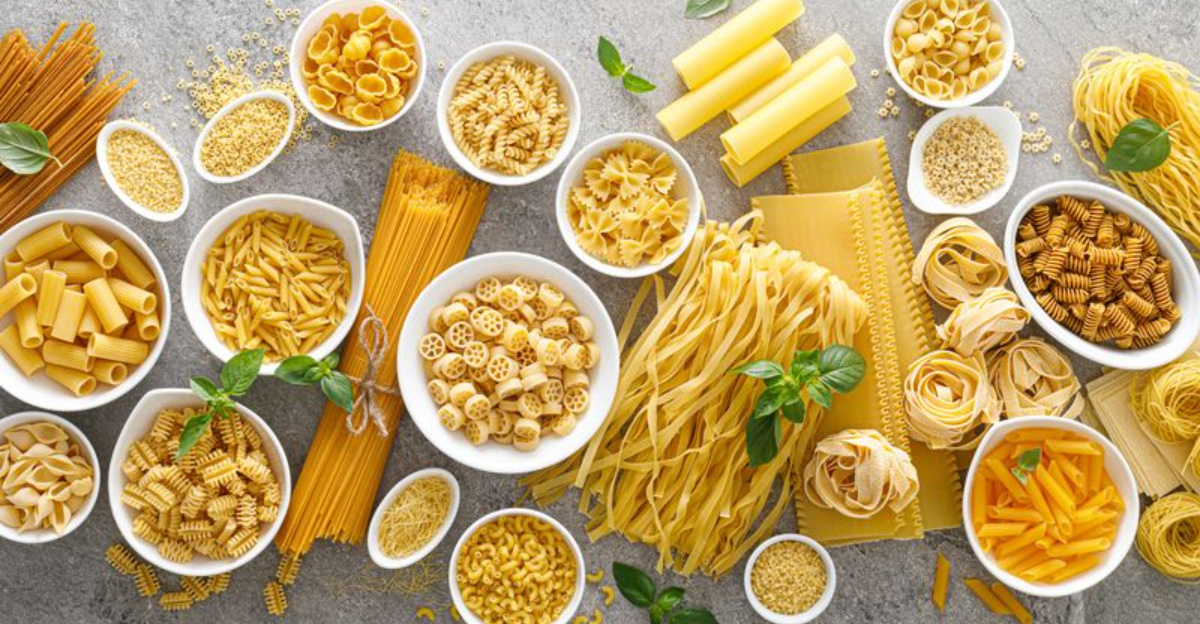12 Tips To Buy The Right Pasta For Any Recipe

Have you ever stood in the pasta aisle, overwhelmed by the endless shapes and varieties, wondering which one would work best for your dinner plans?
I’ve been there too! As someone who’s ruined more than one pasta dish by choosing the wrong noodle, I’ve learned that picking the right pasta isn’t just about aesthetics.
The shape, texture, and quality of your pasta can make or break your recipe, affecting how sauce clings and how the final dish comes together.
1. Match Pasta Shape To Sauce Thickness
Last month I made the rookie mistake of serving angel hair with my chunky Bolognese sauce. What a disaster! The delicate strands collapsed under the weight of those hearty meat chunks. Lesson learned.
Thinner sauces like olive oil or light cream-based ones pair beautifully with delicate pasta shapes like spaghetti or angel hair. These slender noodles get coated evenly without drowning.
Chunky, heartier sauces need pasta with nooks and crannies to trap all that goodness. Think rigatoni, penne, or fusilli for your meaty ragùs or vegetable-packed sauces. The rule of thumb: the chunkier the sauce, the more substantial your pasta should be. Your sauce and pasta should feel like they were made for each other!
2. Inspect The Ingredient List
My Italian grandmother would roll in her grave if she knew how many pasta packages I’ve tossed in my cart without checking what’s actually in them! Quality pasta needs just two ingredients: durum wheat semolina and water. That’s it.
When I see additional ingredients like preservatives, colorings, or too many additives, I now place that package right back on the shelf. The fewer ingredients, the better the pasta usually is.
Authentic Italian pasta often carries a DOP (Protected Designation of Origin) certification, guaranteeing traditional production methods. While these might cost a bit more, the difference in taste and texture is remarkable. Your sauces will cling better, and the pasta won’t turn mushy even if you accidentally overcook it by a minute or two.
3. Look For Bronze-Die Extruded Pasta
“Bronze-die extruded” might sound like manufacturing jargon, but it’s actually pasta magic! During my cooking class in Naples, our chef showed us how pasta pushed through bronze dies (versus cheaper Teflon ones) creates a rougher, more porous surface.
This seemingly small detail makes a world of difference. The sauce doesn’t slide off; it hugs each piece like a long-lost friend. You’ll know bronze-die pasta by its slightly rough texture and sometimes duller appearance compared to the super-smooth, shiny alternatives.
Many premium pasta brands proudly mention “trafilata al bronzo” (bronze-drawn) on their packaging. It might cost a few cents more, but when you notice how much less sauce pools at the bottom of your plate, you’ll realize it’s money well spent!
4. Check For Proper Drying Methods
Ever wonder why some pasta holds its shape perfectly while others turn to mush? The secret lies in how it’s dried. I learned this the hard way after serving what can only be described as pasta porridge at a dinner party!
Quality pasta is dried slowly at low temperatures, sometimes for up to 50 hours. This patient process allows the pasta to develop proper structure and that delightful al dente bite we all crave. Mass-produced options are often speed-dried at high temps, making them prone to breaking during cooking.
How can you tell? Quality slow-dried pasta typically has a more uneven, artisanal appearance with slight color variations. It also tends to have a longer cooking time listed on the package—usually 9-14 minutes rather than 5-7 minutes. Your patience will be rewarded with pasta that maintains its integrity from pot to plate.
5. Consider The Pasta’s Protein Content
Who knew pasta shopping could involve protein counting? Not me, until a chef friend pointed out the tiny numbers on my favorite pasta box. The protein percentage in pasta directly affects how it behaves when cooked.
Higher protein content (12-14%) means the pasta will maintain its structure better during cooking. This is crucial for dishes where you want defined pasta shapes or if you plan to finish cooking your pasta in the sauce. Look for this percentage on the nutritional panel or packaging.
Lower protein pastas aren’t necessarily bad—they can work beautifully in soups or more delicate preparations. But for that perfect plate of carbonara or puttanesca where texture is everything? Reach for the high-protein stuff. My favorite brands typically hover around 13%, giving me that ideal balance between structure and tenderness.
6. Pay Attention To Origin
During my food-focused trip through Italy, I discovered that pasta from different regions isn’t just marketing—it’s tradition backed by centuries of expertise! Southern Italian pasta, particularly from Naples and Sicily, tends to be made with harder wheat varieties perfect for shaping into tubes and twists.
Northern Italian pasta often incorporates eggs and softer wheat, ideal for filled pastas like ravioli or delicate tagliatelle. These regional differences aren’t random but evolved to complement local ingredients and cooking styles.
While you don’t need to be a geography expert, checking where your pasta comes from can offer clues about its intended use. A Sicilian pasta might stand up better to those bold Mediterranean flavors, while a delicate pasta from the north might showcase your subtle cream sauce perfectly. The pasta’s birthplace can be your recipe matchmaker!
7. Assess The Color And Appearance
“Judge a book by its cover” doesn’t usually apply, but with pasta, appearances tell quite a story! After wasting money on pale, lifeless spaghetti that turned to glue in my pot, I’ve learned to be more observant.
Quality pasta has a golden amber color—not too yellow (which might indicate added colorings) and not too white (which could mean refined flours). This natural golden hue comes from using the heart of durum wheat semolina.
Look also for a consistent color throughout. Uneven coloring or white spots can indicate improper drying or lower quality ingredients. The surface should have a slight roughness rather than a perfect, polished appearance. These visual cues aren’t just for food photographers—they’re reliable indicators of how your pasta will perform when the heat is on!
8. Understand Cooking Time Indicators
The cooking time printed on pasta packages isn’t just a suggestion—it’s a window into the pasta’s quality! I used to ignore these numbers until a memorable dinner where my “quick-cook” pasta turned to mush in just 4 minutes.
Quality pasta typically lists longer cooking times (9-14 minutes) because it’s made with better ingredients and traditional methods. The protein structure takes longer to soften properly, resulting in that perfect al dente texture. Pastas advertising super-quick cooking times (3-5 minutes) often achieve this by using softer wheat or thinner extrusion.
For everyday meals, moderate cooking times (7-10 minutes) offer a good balance between convenience and quality. But when I’m making something special? I reach for the pasta with double-digit cooking minutes. Those extra minutes of waiting translate directly to better texture and flavor in the finished dish.
9. Select The Right Size For Your Dish
Size matters! I learned this embarrassing lesson when I served massive paccheri tubes in a delicate seafood dish, forcing my guests to cut their pasta at the table like barbarians.
Smaller pasta shapes work beautifully in soups, light salads, or as side dishes. They cook quickly and provide the perfect bite-sized portion. Medium-sized pastas like penne or farfalle are your all-purpose players—versatile enough for most sauces and substantial enough for main courses.
Larger shapes like paccheri or lasagna sheets should be reserved for heartier, special-occasion dishes where they can truly shine. Consider not just the recipe but also how the dish will be eaten. Will it be a formal sit-down dinner with proper cutlery, or a casual family-style meal? The eating experience should guide your size selection as much as the sauce pairing.
10. Choose The Right Specialty Pasta
The specialty pasta section used to intimidate me with its colored, filled, and oddly-shaped options. After a spinach pasta disaster that turned an unappealing brown when cooked, I’ve learned to navigate these waters more carefully.
Colored pastas (black squid ink, green spinach, red tomato) should be chosen when their flavor complements your dish. That black squid ink pasta? Perfect for seafood, but weird with a cheesy alfredo. Filled pastas like ravioli or tortellini are best served with light sauces that won’t overpower their fillings.
Fresh pasta works wonderfully with delicate, butter-based sauces, while dried pasta stands up better to robust tomato or meat sauces. When buying specialty items, check if they’re colored with natural ingredients rather than artificial dyes. The price might be higher, but the authentic flavors and vibrant appearance make it worthwhile for special meals.
11. Consider Dietary Requirements
My pasta world expanded dramatically when my best friend was diagnosed with celiac disease. Suddenly, I was exploring the universe of gluten-free options to keep our pasta nights alive!
Today’s alternative pastas go way beyond the sad, mushy rice noodles of yesteryear. Chickpea pasta packs a protein punch and holds its shape surprisingly well. Lentil varieties offer earthy flavors that stand up beautifully to rustic sauces. Even veggie-based options like hearts of palm or zucchini “noodles” have their place for those cutting carbs.
The key is matching these alternatives to appropriate sauces. Chickpea pasta works well with stronger flavors that complement its nutty profile. More delicate alternatives like rice pasta need gentler treatment and often benefit from being slightly undercooked. Don’t be afraid to experiment—some of my favorite pasta dishes now feature these once-alternative options!
12. Examine Packaging And Storage Indicators
The humble pasta package reveals more secrets than you might think! After discovering weevils in an improperly sealed bag of linguine (nightmare fuel!), I’ve become somewhat obsessive about packaging quality.
Look for packages that protect pasta from light, moisture, and air—the three enemies of pasta freshness. Clear windows might look pretty but allow damaging light exposure. Properly sealed packages with minimal air inside typically indicate better quality control during production.
Check expiration dates, but more importantly, inspect how the pasta is stored at the store. If it’s near heat sources or in direct sunlight, keep walking! Once home, transfer pasta to airtight containers and store in cool, dark places. This small step extends shelf life dramatically and preserves that fresh-made taste. Quality pasta can last 1-2 years when stored properly, though I rarely manage to keep it around that long!
